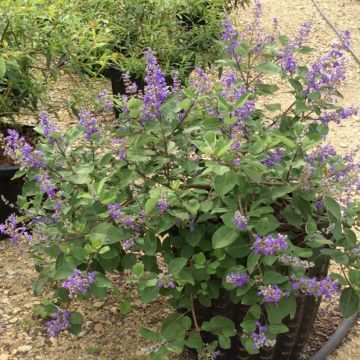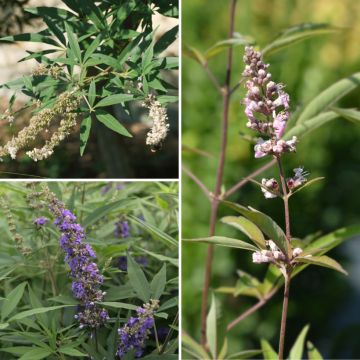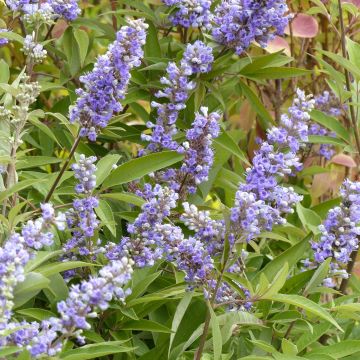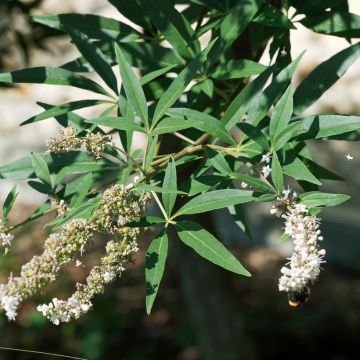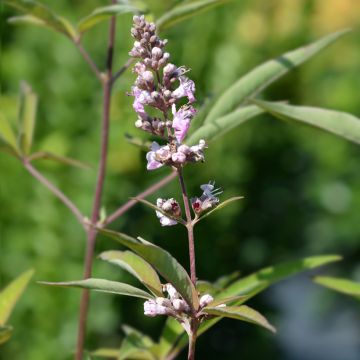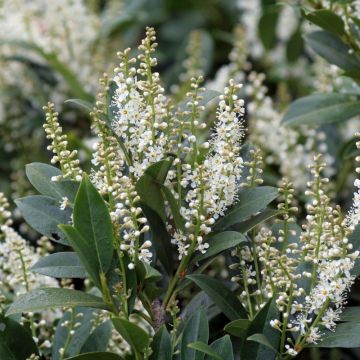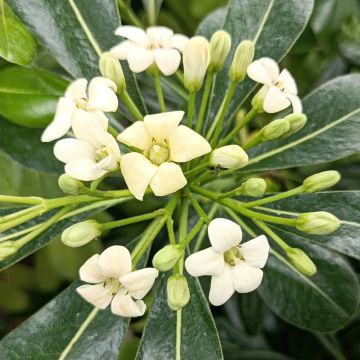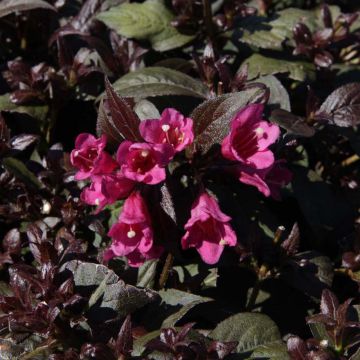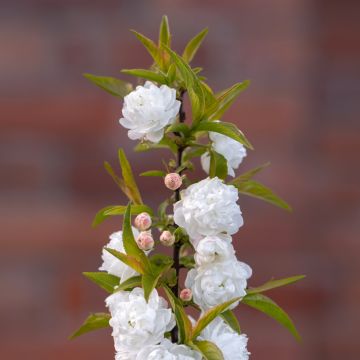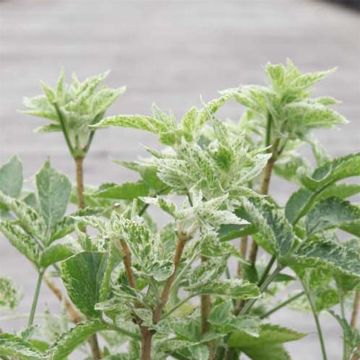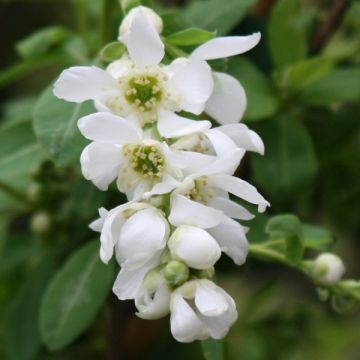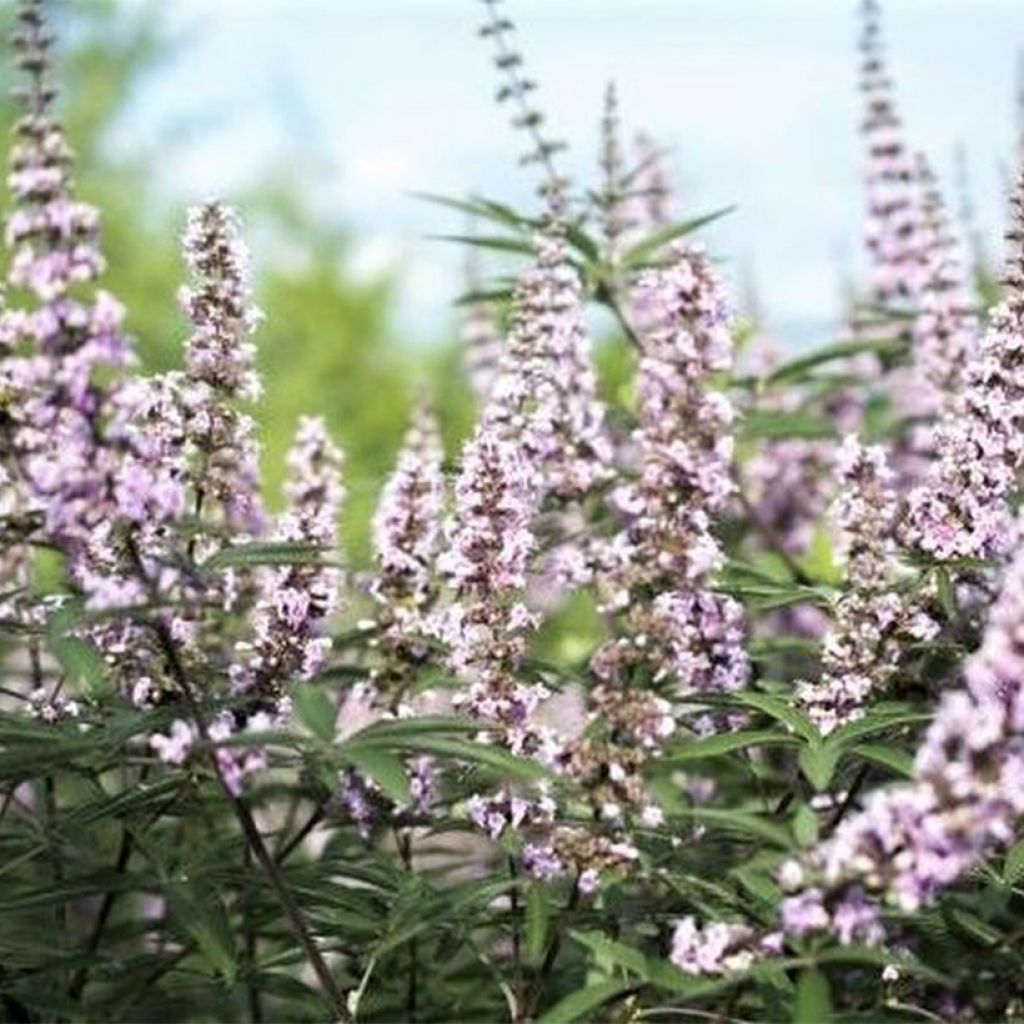

Vitex agnus-castus Galactic Pink - Chaste Tree
Vitex agnus-castus Galactic Pink - Chaste Tree
Vitex agnus-castus Galactic Pink 'Bailtextwo'
Chaste Tree, Monk's Pepper, Chasteberry, Chaste Lamb
This item cannot be shipped to the selected country
Delivery charge from €5.90
More information
Schedule delivery date,
and select date in basket
This plant carries a 24 months recovery warranty
More information
We guarantee the quality of our plants for a full growing cycle, and will replace at our expense any plant that fails to recover under normal climatic and planting conditions.
From €5.90 for pickup delivery and €6.90 for home delivery
Express home delivery from €8.90.

Does this plant fit my garden?
Set up your Plantfit profile →
Description
Vitex agnus-castus 'Galactic Pink' distinguishes itself from the classic chaste tree by its more compact growth and pale pink flowering in upright spikes. While not spectacular, it is unusual and provides a good source of nectar for bees in late summer. Like the wild species, which is sometimes called Monk's Pepper or Chaste Lamb, this Galactic Pink variety produces red and shiny 'peppercorns' that persist throughout winter. Its beautiful palmate foliage is aromatic when crushed. This deciduous shrub is hardy, undemanding, tolerant of salty soils, and drought-resistant once established. Easy to grow, it thrives in a free hedge.
Vitex agnus-castus 'Galactic Pink' is a recent American horticultural creation. It is a beautiful deciduous shrub from the Verbenaceae family. Its wild ancestor is native to the Mediterranean basin and Asia Minor, where it is frequently found by the seaside, planted in sand and exposed to sea spray. This 'Galactic Pink' variety forms a generally rounded and densely bushy shrub within a few years. When fully grown, it will measure approximately 2 m (7 ft) in all directions, depending on the growing conditions. Its flowering occurs from early August to late September, depending on the climate, on the current year's shoots. It takes the form of thin floral spikes, slightly smaller than those of Delta Blues. They are adorned with tiny fragrant flowers ranging from pink to pale pink. Then small fruits the size of peppercorns appear, which are aromatic, dark red and shiny, and persist until winter. The fast-growing stems are strong and very flexible. They bear palmate leaves, divided into 5 tapering lobes, and their colour is a beautiful dark green. This deciduous foliage turns yellow in autumn before falling. When crushed, it emits a strong pepper scent, hence its nickname of Pepper Tree. Vitex plants develop a very deep root system, allowing them to draw moisture from deep down when the summer is dry.
Often found by the coast, Vitex agnus-castus is highly resistant to summer drought once well rooted. Having retained the qualities of this undemanding and sturdy shrub, the 'Galactic Pink' variety is an excellent plant for coastal gardens. Its cold resistance (down to -15 °C (5 °F)) makes it accessible to many natural or non-irrigated gardens. It can be integrated into a free hedge or grove, alongside oleanders (in mild climates), botanical roses, Crape Myrtles, buddleias, or even summer tamarisks.
Its vernacular name of 'Monk's Pepper' dates back to the Middle Ages, when some clergymen consumed the shrub's berries to resist the temptations of the flesh. Since then, studies have proven the plant's properties in alleviating problems related to hormonal fluctuations in women. In Ancient Greece, Vitex stems were used to make strong bindings. Legend has it that Ulysses tied his companions with such ties under the bellies of sheep, allowing them to escape from the Cyclops' cave.
Report an error about the product description
Vitex agnus-castus Galactic Pink - Chaste Tree in pictures
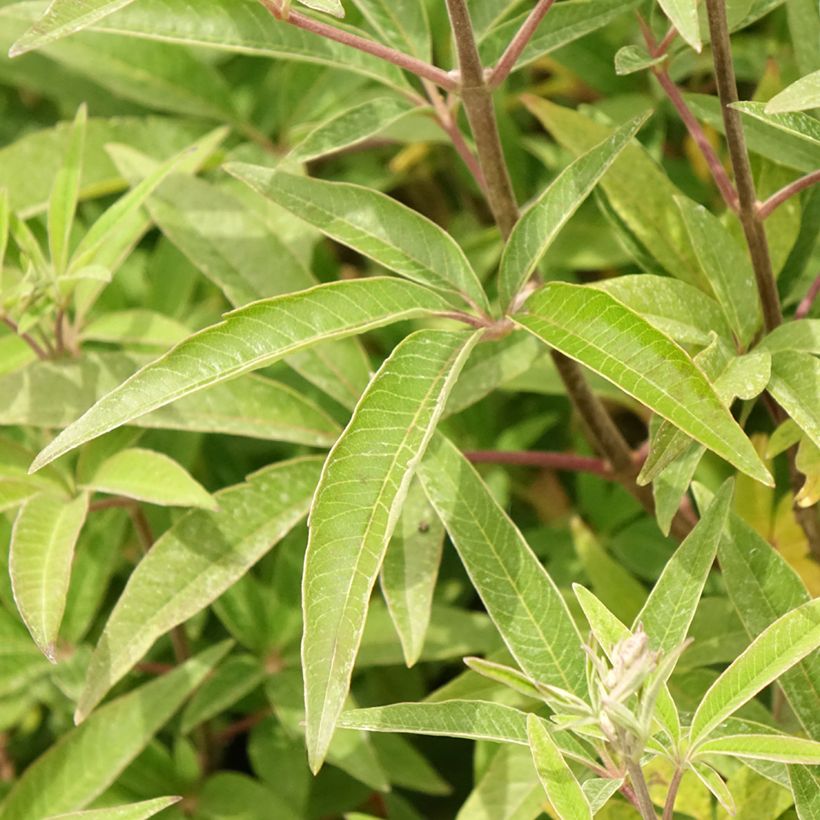

Plant habit
Flowering
Foliage
Botanical data
Vitex
agnus-castus
Galactic Pink 'Bailtextwo'
Verbenaceae
Chaste Tree, Monk's Pepper, Chasteberry, Chaste Lamb
Cultivar or hybrid
Other Vitex - Chaste tree
Planting and care
Plant Vitex 'Galactic Pink' in a sunny position in well-drained, preferably deep soil. This shrub is not very demanding in terms of the nature of the soil, whether it is chalky, neutral or slightly acidic. It withstands sea spray and brackish water very well. Shelter it from cold, drying winds and water in case of prolonged drought during the first few years. It fears very strong frosts, especially if the soil it is planted in is too clayey and poorly drained.
Planting period
Intended location
Care
-
, onOrder confirmed
Reply from on Promesse de fleurs
Hedge shrubs
Haven't found what you were looking for?
Hardiness is the lowest winter temperature a plant can endure without suffering serious damage or even dying. However, hardiness is affected by location (a sheltered area, such as a patio), protection (winter cover) and soil type (hardiness is improved by well-drained soil).

Photo Sharing Terms & Conditions
In order to encourage gardeners to interact and share their experiences, Promesse de fleurs offers various media enabling content to be uploaded onto its Site - in particular via the ‘Photo sharing’ module.
The User agrees to refrain from:
- Posting any content that is illegal, prejudicial, insulting, racist, inciteful to hatred, revisionist, contrary to public decency, that infringes on privacy or on the privacy rights of third parties, in particular the publicity rights of persons and goods, intellectual property rights, or the right to privacy.
- Submitting content on behalf of a third party;
- Impersonate the identity of a third party and/or publish any personal information about a third party;
In general, the User undertakes to refrain from any unethical behaviour.
All Content (in particular text, comments, files, images, photos, videos, creative works, etc.), which may be subject to property or intellectual property rights, image or other private rights, shall remain the property of the User, subject to the limited rights granted by the terms of the licence granted by Promesse de fleurs as stated below. Users are at liberty to publish or not to publish such Content on the Site, notably via the ‘Photo Sharing’ facility, and accept that this Content shall be made public and freely accessible, notably on the Internet.
Users further acknowledge, undertake to have ,and guarantee that they hold all necessary rights and permissions to publish such material on the Site, in particular with regard to the legislation in force pertaining to any privacy, property, intellectual property, image, or contractual rights, or rights of any other nature. By publishing such Content on the Site, Users acknowledge accepting full liability as publishers of the Content within the meaning of the law, and grant Promesse de fleurs, free of charge, an inclusive, worldwide licence for the said Content for the entire duration of its publication, including all reproduction, representation, up/downloading, displaying, performing, transmission, and storage rights.
Users also grant permission for their name to be linked to the Content and accept that this link may not always be made available.
By engaging in posting material, Users consent to their Content becoming automatically accessible on the Internet, in particular on other sites and/or blogs and/or web pages of the Promesse de fleurs site, including in particular social pages and the Promesse de fleurs catalogue.
Users may secure the removal of entrusted content free of charge by issuing a simple request via our contact form.
The flowering period indicated on our website applies to countries and regions located in USDA zone 8 (France, the United Kingdom, Ireland, the Netherlands, etc.)
It will vary according to where you live:
- In zones 9 to 10 (Italy, Spain, Greece, etc.), flowering will occur about 2 to 4 weeks earlier.
- In zones 6 to 7 (Germany, Poland, Slovenia, and lower mountainous regions), flowering will be delayed by 2 to 3 weeks.
- In zone 5 (Central Europe, Scandinavia), blooming will be delayed by 3 to 5 weeks.
In temperate climates, pruning of spring-flowering shrubs (forsythia, spireas, etc.) should be done just after flowering.
Pruning of summer-flowering shrubs (Indian Lilac, Perovskia, etc.) can be done in winter or spring.
In cold regions as well as with frost-sensitive plants, avoid pruning too early when severe frosts may still occur.
The planting period indicated on our website applies to countries and regions located in USDA zone 8 (France, United Kingdom, Ireland, Netherlands).
It will vary according to where you live:
- In Mediterranean zones (Marseille, Madrid, Milan, etc.), autumn and winter are the best planting periods.
- In continental zones (Strasbourg, Munich, Vienna, etc.), delay planting by 2 to 3 weeks in spring and bring it forward by 2 to 4 weeks in autumn.
- In mountainous regions (the Alps, Pyrenees, Carpathians, etc.), it is best to plant in late spring (May-June) or late summer (August-September).
The harvesting period indicated on our website applies to countries and regions in USDA zone 8 (France, England, Ireland, the Netherlands).
In colder areas (Scandinavia, Poland, Austria...) fruit and vegetable harvests are likely to be delayed by 3-4 weeks.
In warmer areas (Italy, Spain, Greece, etc.), harvesting will probably take place earlier, depending on weather conditions.
The sowing periods indicated on our website apply to countries and regions within USDA Zone 8 (France, UK, Ireland, Netherlands).
In colder areas (Scandinavia, Poland, Austria...), delay any outdoor sowing by 3-4 weeks, or sow under glass.
In warmer climes (Italy, Spain, Greece, etc.), bring outdoor sowing forward by a few weeks.

































